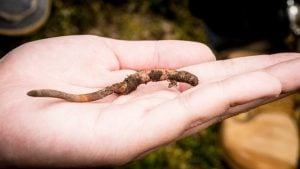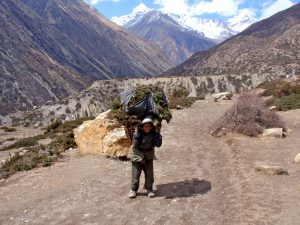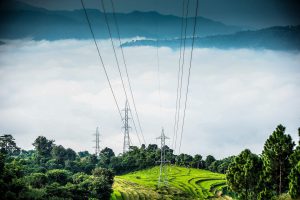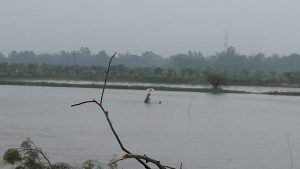Last year, Behram Baig left his job at a large corporation in Karachi and moved back home to the Passu valley to start a new life: promoting the use of sea buckthorn. Baig wanted to tell people about the plant’s multiple health benefits and inspire others to make a living from it.
Sea buckthorn is a deciduous shrub found across Europe and Asia. It produces small orange berries once a year, which are turned into pastes, liquids and oils for a variety of uses. Traditionally, the plant is used as medicine for blood pressure, cholesterol, asthma, ulcers, hepatitis, digestion and healing skin damage such as burns, rashes, cuts and sunburn. Women also use it as makeup or sun-block.
Baig grew up in a small mountainous village on the banks of the Hunza River near the Pakistan-China border. He moved to Karachi to study in the early 1990s and worked in marketing and security. He became interested in the healing properties of sea buckthorn berries after using them to control his blood pressure, and was struck by the idea of promoting its use as a way to earn a living.
“I was earning a good wage from my job [in Karachi], but I have got more satisfaction from working at a community level for the promotion of natural resources,” says Baig.
After arriving back to his home village of Passu, Baig joined others who were already collecting sea buckthorn to make a variety of products including jams, syrups, dried fruit, green tea, oil and chocolate.
“Sea buckthorn is a medicine for at least 70 diseases and has been used by villagers for centuries,” says Baig. “It is 100% organic because sea buckthorn plants are only grown in areas where glacial water is available. You know that no one can contaminate the glacier with urea or harmful chemicals.” Many people in mountainous areas of Pakistan, particularly older people, have never used antibiotics, relying instead on natural medicine such as sea buckthorn, shilajit and herbs.

“It seems that within a short amount of time, I will be able to earn more than I was earning from my job [in Karachi],” he says. And this is not the only advantage to being back in his home village. Thanks to his previous role in marketing, Baig hopes to show other villagers how to promote and publicise the use of sea buckthorn effectively. Many villagers have been collecting and selling organic sea buckthorn products for years, but have failed to market them successfully due to a lack of communication skills.
Read more: Rise and fall of apples in Manang
Wazir Aman, a sea buckthorn farmer since 2001, is optimistic about the prospect of earning more money. He believes that his difficult days are over, and now the time for earning is beginning. He makes jams, syrups, green tea and dried fruit from the plant and earns PKR 600,000 (almost USD 6,000) every year. He has attended many exhibitions and workshops on processing and packaging sea buckthorn products, in Pakistan and abroad, with the support of different organisations, such as the Aga Khan Rural Development Program (AKRSP).
Even so, almost 95% of sea buckthorn is still wasted due to a lack of technical and financial support available to farmers. Aman believes that the government must take an holistic approach to promote the health benefits of the plant around the country and, as sea buckthorn is used as fuel for cooking and heating, insists that alternative sources be found for people in mountainous areas.
Sea buckthorn has gained popularity in recent years, and not just at the community level. The state government of Gilgit-Baltistan and some NGOs such as the AKRSP and the International Centre for Integrated Mountain Development (ICIMOD) have jumped into the fray, promoting it as a way to improve the livelihoods of communities.
With the help of ICIMOD, AKRSP has launched training, awareness and exposure programmes on value chains for local communities in Ghizer district and in the upper Hunza valley. Those areas, as well as the town of Skardu, have high potential for sea buckthorn products, according to an upcoming study conducted by AKRSP. However, the plant is still one of the most underutilised resources in mountainous areas of Gilgit-Baltistan, despite its multiple advantages.
More than 12 million sea buckthorn plants cover 5,700 hectares in the area. Some 87% of families in mountainous areas have sea buckthorn on their land and the area covered by AKRSP’s study produces almost 6,000 metric tonnes of fresh berries every year. With an effective management plan, this quantity could be multiplied several times and generate more than PKR 300 million (USD 30 million) every year.
Amjad Wali, a senior officer of Gilgit-Baltistan’s planning and development department, said that the provincial government has included a project for the promotion of sea buckthorns in its current development programme. The project will focus on the value chain of sea buckthorn related products by training farmers, particularly women, at village level. Community members will also be helped to establish value chains and marketing strategies. “Our vision is improving the self-employment opportunities of mountain farmers to enhance their earning,” says Wali.
![<p>A handful of harvested sea buckthorn berries [image: Asian Development Bank via Flickr]</p>](https://dialogue.earth/content/uploads/2017/09/16742283273_cbcd3331ae_k-e1505147439314.jpg)






![A Kashmiri man near a Budgam forest shows the degradation caused to forests over the past few decades [image by: Athar Parvaiz]](https://dialogue.earth/content/uploads/2017/09/A-Kashmiri-man-near-a-Budgam-forest-shows-the-degradation-caused-to-firests-over-the-past-few-decades-Photo-__-Athar-Parvaiz--300x199.jpg)
